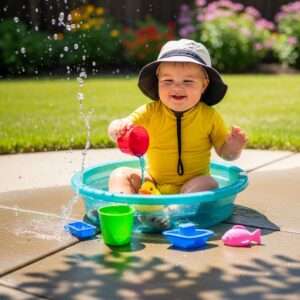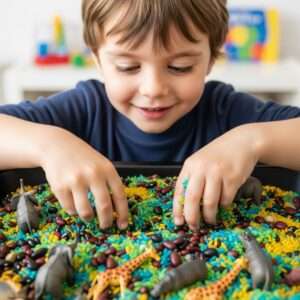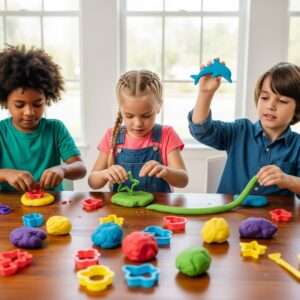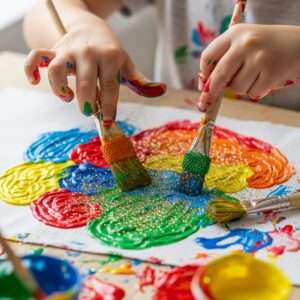Sensory play is more than just fun for children—it’s a critical part of their growth and development.
By engaging their senses through touch, sight, sound, smell, and taste, children build essential cognitive, motor, and social skills.
Sensory play helps with language development, emotional regulation, and problem-solving abilities.
Whether you’re a parent, caregiver, or educator, exploring creative sensory play ideas can make learning exciting and hands-on.
Here are some inspiring ideas to incorporate into your child’s daily activities.
1. Water Play

Water play is a timeless favorite for children of all ages.
Filling a small tub or basin with water and adding cups, spoons, and small toys encourages pouring, scooping, and measuring, which develops fine motor skills.
You can also introduce elements like ice cubes, food coloring, or floating objects to make it more engaging.
Water play teaches cause and effect, helps children understand different textures, and offers a calming sensory experience.
2. Sensory Bins

Sensory bins are containers filled with materials that stimulate a child’s sense of touch.
Popular choices include rice, beans, sand, or pasta, often mixed with small toys or objects to discover.
Children enjoy digging, sifting, and sorting, which strengthens hand-eye coordination.
You can create themed bins for holidays or seasons, such as a Halloween bin with tiny pumpkins or a winter bin with faux snow.
Sensory bins also encourage imaginative play and independent exploration.
3. Playdough and Clay Activities

Playdough and clay are excellent for tactile exploration and creativity.
Rolling, squishing, and shaping the dough strengthens fine motor skills and hand muscles, which are crucial for writing and drawing.
You can enhance the sensory experience by adding scents, such as lavender or citrus, or textures like glitter or beads.
Children can use molds, cookie cutters, or tools to create objects, boosting their creativity and problem-solving skills.
4. Nature-Based Sensory Play

Taking sensory play outdoors allows children to engage with natural textures, sounds, and smells.
Collect leaves, pinecones, rocks, or flowers and encourage children to explore their shapes, colors, and textures.
Activities like digging in soil, splashing in puddles, or feeling the grass stimulate touch, while listening to birds or rustling leaves enhances auditory awareness.
Nature-based play also promotes curiosity about the environment and teaches children to observe and appreciate the world around them.
5. Sensory Art Projects

Art can be a powerful sensory experience.
Using materials like finger paints, textured paper, sand art, or even edible paints encourages children to experiment with colors, patterns, and textures.
Art activities stimulate creativity and provide opportunities for self-expression while improving fine motor skills.
You can also integrate scents, like scented markers or herbs, to create a multi-sensory masterpiece.
6. Music and Sound Play

Engaging children with different sounds and musical instruments enhances auditory processing and rhythm skills.
Simple instruments like shakers, tambourines, or homemade drums provide opportunities for experimentation and self-expression.
Encourage children to create rhythms, sing along, or match sounds to movements.
Sound play also helps children develop listening skills, memory, and emotional awareness, making it both educational and fun.
Read More: Newborn Halloween Costumes
7. Sensory Bottles

Sensory bottles are clear containers filled with water, glitter, beads, or small objects that children can shake, roll, or observe.
These bottles provide visual stimulation and can have a calming effect, helping children regulate emotions and focus.
You can create themed bottles, such as ocean scenes with shells and blue water or space-themed bottles with stars and tiny planets.
Sensory bottles are portable and perfect for quiet play at home or on the go.
8. Edible Sensory Play

For younger children, edible sensory play combines exploration with safe tasting experiences.
Activities like exploring different textures of fruits, vegetables, or gelatin can be both educational and tasty.
Children learn about colors, shapes, and textures while practicing fine motor skills and hand-eye coordination.
Always supervise edible play to ensure safety, and encourage children to describe the flavors, smells, and textures they experience.
9. Light and Shadow Play

Light and shadow play stimulates visual senses and encourages experimentation with cause and effect.
Using a flashlight, colored lights, or a simple lamp, children can observe shadows, reflections, and shapes.
You can introduce objects of different sizes and transparency to create unique shadow patterns.
This type of sensory play encourages curiosity, creativity, and cognitive development, especially when combined with storytelling or imaginative scenarios.
Sensory play is a fun and essential part of a child’s development.
By incorporating a variety of tactile, auditory, visual, and even edible experiences, you can create engaging activities that enhance learning, creativity, and motor skills.
These sensory play ideas provide endless opportunities for exploration, experimentation, and connection with your child, making learning a joyful and interactive experience.
Affiliate Disclosure: As an Amazon Associate, I earn from qualifying purchases. This post may contain affiliate links. This means I may earn a small commission at no extra cost to you.



